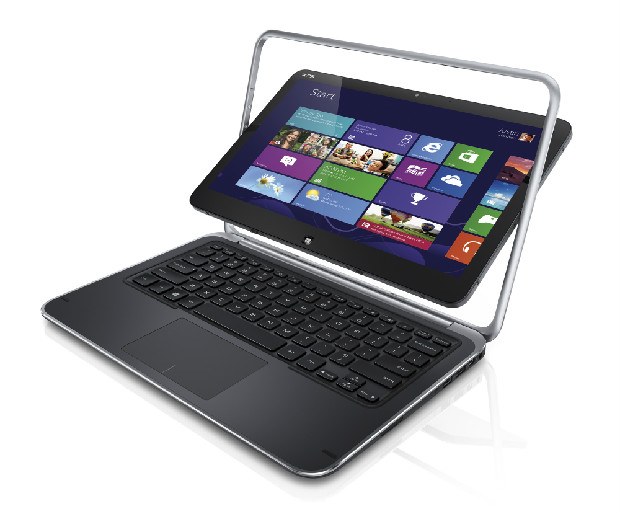Latest Dell XPS 12 comes close to a true 2-in-1

The concept of a hybrid holds lot of appeal, but I've yet to to find one that is both a great laptop and a good tablet. We are getting closer, though. The latest version of the Dell XPS 12, which has been updated with Intel's Haswell processor, is one of the best 2-in-1s to date.
There are many different approaches to convertibles. The XPS 12, which I've been using on and off for several weeks at the office, at home, and on the road, relies on a "flip hinge", which lets the screen rotate 180 degrees inside its frame so you can fold it flat to use it like a tablet. This isn't the first time Dell has tried this — it has experimented with the flip hinge on other laptops — but this time, it got it right. The hinge is smooth and sturdy, the aluminum frame barely flexes, and the display clicks into place. The base is constructed of the same high-quality materials, giving the XPS 12 a solid and sophisticated feel.

The XPS 12's display stands out in other ways, too. The 12.5-inch full HD display is bright (Dell says 400 nits), has wide viewing angles, and is covered edge to edge with Corning Gorilla Glass on the front and a carbon fiber composite on the back. The only trouble I had with the display is that I often had to pick up the entire system and rotate it from side to side to get the screen oriented correctly (the XPS 12 has a rotation lock button, but it simply turns auto-rotation on and off). Dell wasn't able to duplicate the problem, but other reviewers and users have noted the same issue.
The XPS 12 starts at $1,000, but the system I tested with a faster processor (the 1.6GHz Core i5-4200U capable of bursts up to 2.3GHz), 4GB of memory, and a larger, 128GB solid-state drive (SSD) is $1,200. Dell offers faster Core i7 processors, up to 8GB of memory and larger capacity SSDs, but the model I tested delivered plenty of performance for most users.
The battery life is even more impressive (Intel says that Haswell delivered the largest boost in battery life form one generation to the next in its history, and indeed that seems to be the case). The six-cell (50WHr) battery, which isn't swappable, often lasted around 7 hours in typical use — even with the display brightness cranked up. For most users, this will be the biggest benefit of Haswell and its successor, the 14nm Broadwell family due in 2014.
The XPS 12 has two USB 3.0 ports (one of which can charge devices even when the system is off), mini DisplayPort for connecting external displays, and a combination headphone/microphone jack. There is no SD or microSD card slot, nor an Ethernet jack, though you can use a USB adapter.
It does, however, have 802.11ac Wi-Fi, Bluetooth 4.0, and built-in near-field communication (NFC), which lets you tap to connect with devices such as the Jabra Revo wireless headphones, but the number of peripherals that support this feature is limited. The built-in audio is also a step up from what you typically get in a laptop.
Featured
One of the biggest surprises with the XPS 12 is the keyboard, which is among the best I've tried on laptops this size.
The large keys are widely spaced, and they have a soft feel and plenty of travel, which makes for accurate, comfortable typing. The keyboard is also backlit and, according to Dell, spill resistant. The glass touch pad with integrated left and right buttons generally worked fine, though I had a bit of trouble with the two-finger scrolling.
The XPS 12 is only 15-20 millimeters thick and weighs 3.4 pounds. That's just fine for a laptop — it easily qualifies as an ultrabook — but it's still a bit big and heavy for a tablet. In tablet mode, it works well for browsing the web or checking email — and the larger touchscreen is nice to use — but it's tougher to hold it in your hands for a long period of time to, for example, read an ebook or watch a movie.
Having said that, you can always flip the screen around so that the keyboard is in the back, and use the XPS 12 in a hands-free display mode.
Later this year, Dell plans to release a smaller XPS 11 convertible, which should be a little easier to use in tablet mode.
The competition in this space is getting tougher. HP has the Ivy Bridge-based Split x2 and recently announced the Spectre x2 — both of which have a detachable 13.3-inch display. And for business users, it has the Ivy Bridge-based HP EliteBook Revolve with an 11.6-inch swiveling display. Earlier this month, Lenovo announced the Yoga 2 Pro with a 13.3-inch QHD+ (3,200x1,800) display and a ThinkPad Yoga with a 12.5-inch display — both with fourth-generation Core processors. Sony has the Vaio Duo slider 11 and a newer 13-inch model with Haswell Core processors.
The Dell XPS 12 is an excellent ultraportable laptop with a great display, solid performance, and very good battery life. It is also a decent Windows 8 tablet. For most users, I'd still recommend having a separate best-of-breed laptop and an Android tablet or iPad. But for those who really want a hybrid device, the XPS 12 is easily one of the top choices right now.